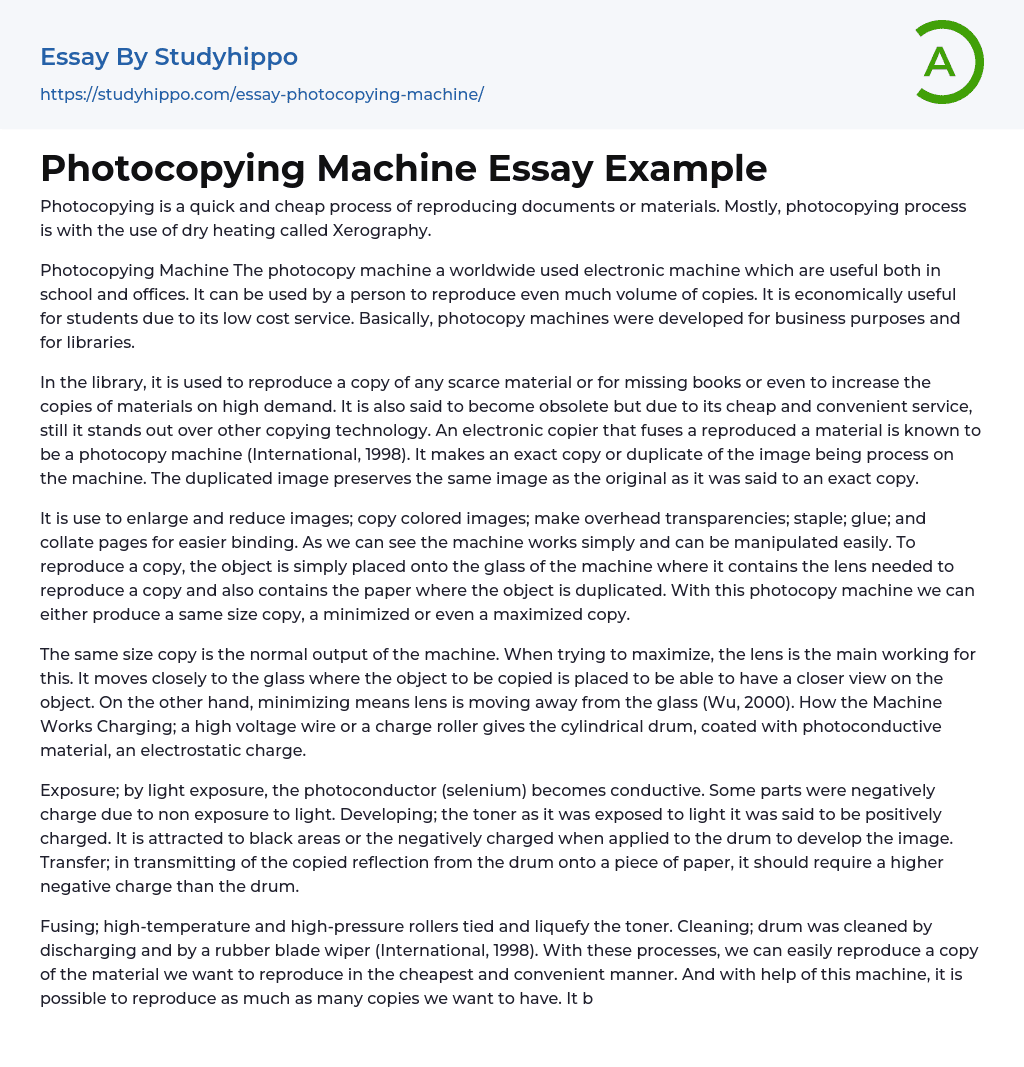Photocopying is a quick and cheap process of reproducing documents or materials. Mostly, photocopying process is with the use of dry heating called Xerography.
Photocopying Machine The photocopy machine a worldwide used electronic machine which are useful both in school and offices. It can be used by a person to reproduce even much volume of copies. It is economically useful for students due to its low cost service. Basically, photocopy machines were developed for business purposes and for libraries.
In the library, it is used to reproduce a copy of any scarce material or for missing books or even to increase the copies of materials on high demand. It is also said to become obsolete but due to its cheap and convenient service, still it stands out
...over other copying technology. An electronic copier that fuses a reproduced a material is known to be a photocopy machine (International, 1998). It makes an exact copy or duplicate of the image being process on the machine. The duplicated image preserves the same image as the original as it was said to an exact copy.
It is use to enlarge and reduce images; copy colored images; make overhead transparencies; staple; glue; and collate pages for easier binding. As we can see the machine works simply and can be manipulated easily. To reproduce a copy, the object is simply placed onto the glass of the machine where it contains the lens needed to reproduce a copy and also contains the paper where the object is duplicated. With this photocopy machine we can either produce a same size copy, a minimized or even a maximized
copy.
The same size copy is the normal output of the machine. When trying to maximize, the lens is the main working for this. It moves closely to the glass where the object to be copied is placed to be able to have a closer view on the object. On the other hand, minimizing means lens is moving away from the glass (Wu, 2000). How the Machine Works Charging; a high voltage wire or a charge roller gives the cylindrical drum, coated with photoconductive material, an electrostatic charge.
Exposure; by light exposure, the photoconductor (selenium) becomes conductive. Some parts were negatively charge due to non exposure to light. Developing; the toner as it was exposed to light it was said to be positively charged. It is attracted to black areas or the negatively charged when applied to the drum to develop the image. Transfer; in transmitting of the copied reflection from the drum onto a piece of paper, it should require a higher negative charge than the drum.
Fusing; high-temperature and high-pressure rollers tied and liquefy the toner. Cleaning; drum was cleaned by discharging and by a rubber blade wiper (International, 1998). With these processes, we can easily reproduce a copy of the material we want to reproduce in the cheapest and convenient manner. And with help of this machine, it is possible to reproduce as much as many copies we want to have. It became so useful that everyone will be able to use this kind of machine.
- Incandescent Light Bulb essays
- Computer Components essays
- Computer Peripherals essays
- Personal Computer essays
- Electric Charge essays
- Atom essays
- Big Bang Theory essays
- Density essays
- Electricity essays
- Energy essays
- Force essays
- Heat essays
- Light essays
- Motion essays
- Nuclear Power essays
- Physiology essays
- Sound essays
- Speed essays
- Temperature essays
- Thermodynamics essays
- Electron essays
- John Locke essays
- 9/11 essays
- A Good Teacher essays
- A Healthy Diet essays
- A Modest Proposal essays
- A&P essays
- Academic Achievement essays
- Achievement essays
- Achieving goals essays
- Admission essays
- Advantages And Disadvantages Of Internet essays
- Alcoholic drinks essays
- Ammonia essays
- Analytical essays
- Ancient Olympic Games essays
- APA essays
- Arabian Peninsula essays
- Argument essays
- Argumentative essays
- Art essays
- Atlantic Ocean essays
- Auto-ethnography essays
- Autobiography essays
- Ballad essays
- Batman essays
- Binge Eating essays
- Black Power Movement essays
- Blogger essays
- Body Mass Index essays




